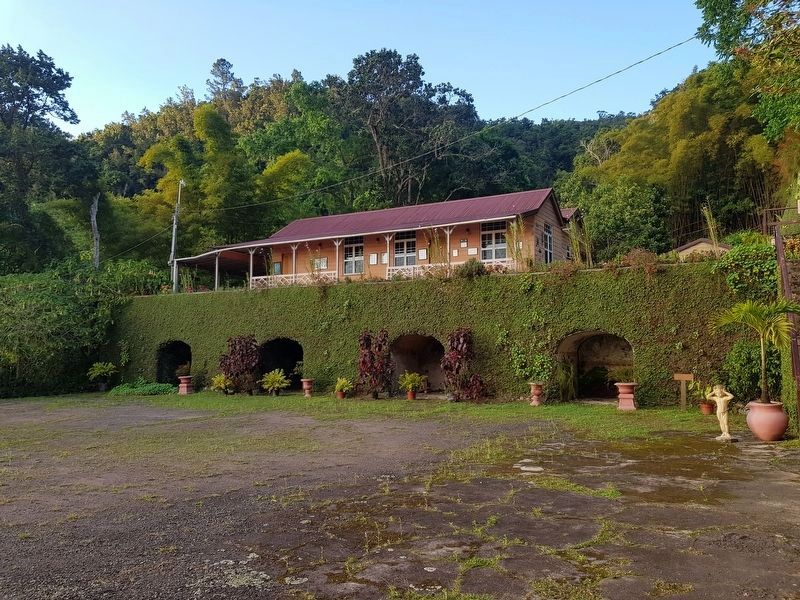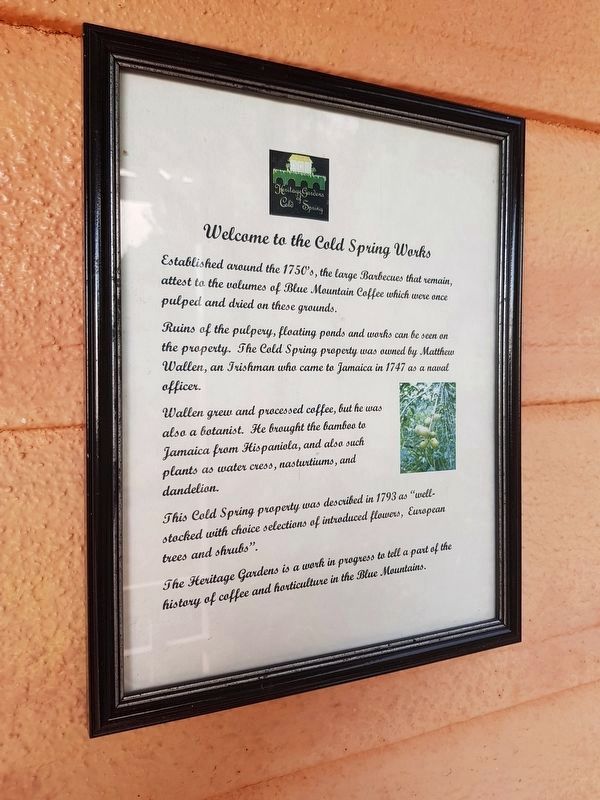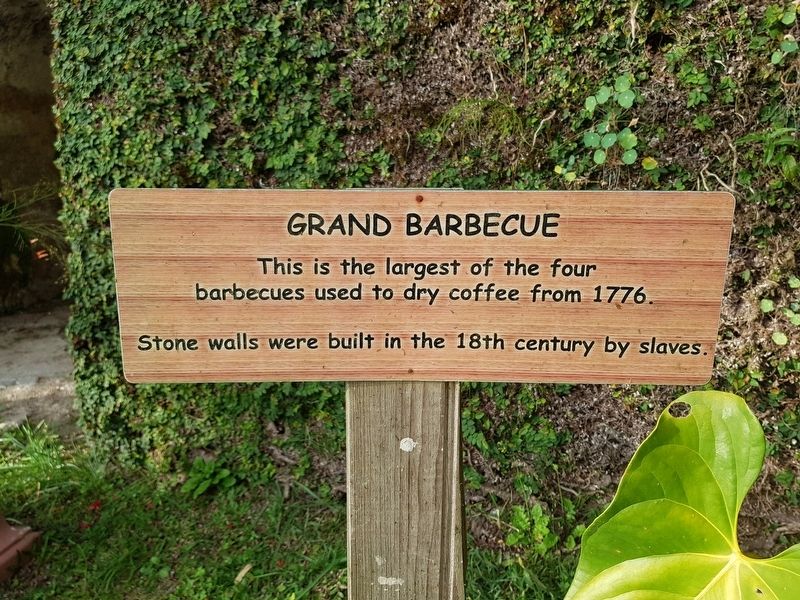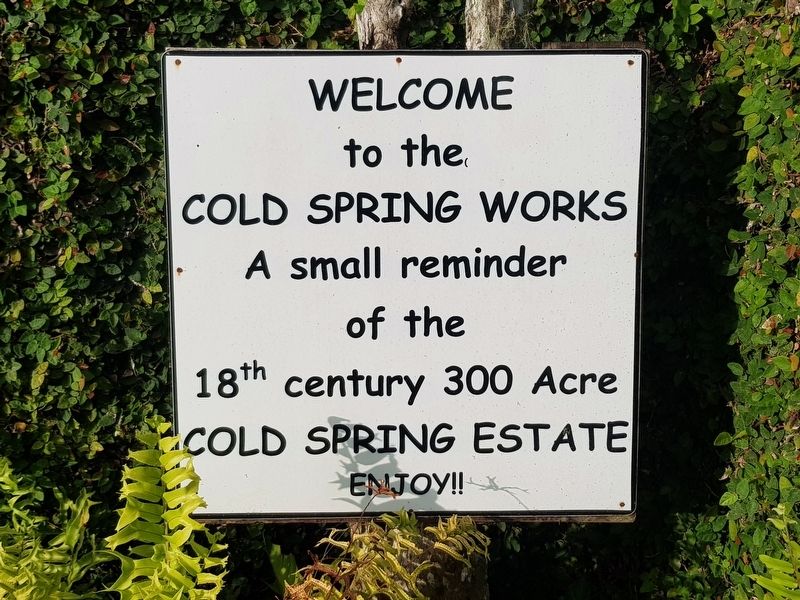Near Industry Village, St Andrew Parish, Jamaica — Caribbean Region of the Americas (Greater Antilles of the West Indies)
The Grand Barbecue at Cold Spring Estate
Inscription.
Grand Barbecue
This is the largest of the four barbecues used to dry coffee from 1776.
Stone walls were built in the 18th century by slaves.
Topics. This historical marker is listed in these topic lists: Agriculture • Colonial Era • Industry & Commerce • Man-Made Features. A significant historical year for this entry is 1776.
Location. 18° 4.344′ N, 76° 42.446′ W. Marker is near Industry Village, St Andrew Parish. Marker can be reached from Route B1, on the right when traveling north. The marker and ex-estate are about 1 km before the Newcastle military installation on B1, traveling north from Kingston. Touch for map. Touch for directions.
Other nearby markers. At least 8 other markers are within 13 kilometers of this marker, measured as the crow flies. Bob Marley (approx. 9.6 kilometers away); Rita Marley (approx. 9.6 kilometers away); Sir William Alexander Bustamante (approx. 11.6 kilometers away); Marcus Mossiah Garvey (approx. 11.6 kilometers away); Norman Washington Manley (approx. 11.6 kilometers away); George William Gordon (approx. 11.7 kilometers away); Paul Bogle (approx. 11.7 kilometers away); The Order of National Hero (approx. 11.7 kilometers away).
Regarding The Grand Barbecue at Cold Spring Estate. Coffee was probably first introduced into Jamaica in the 1740s, most likely brought from the French island of Martinique.

Photographed By J. Makali Bruton, February 2, 2019
3. The Grand Barbecue at Cold Spring Estate Marker
The 'barbecue' mentioned in the marker text refers to the large paved area in front of the terrace and current small hotel. The 'stone walls built by slaves' refers to the large wall with arched recesses covered with vegetation, also seen in this view.

Photographed By J. Makali Bruton, February 2, 2019
4. Additional history of the Cold Spring Estate
The small hotel at Cold Spring Estate includes many additional signs which describe the history of the property. This additional sign reads:
Welcome to the Cold Spring Works
Established around the 1750's, the large Barbecues that remain, attest to the volumes of Blue Mountain Coffee which were once pulped and dried on these grounds. Ruins of the pulpery, floating ponds and works can be seen on the property. The Cold Spring property was owned by Matthew Wallen, an Irishman who came to Jamaica in 1747 as a naval officer. Wallen grew and processed coffee, but he was also a botanist. He brought the bamboo to Jamaica from Hispaniola, and also such plants as water cress, nasturtiums, and dandelion. This Cold Spring property was described in 1793 as "well stocked with choice selections of introduced flowers, European trees and shrubs". The Heritage Gardens is a work in progress to tell a part of the history of coffee and horticulture in the Blue Mountains.
Welcome to the Cold Spring Works
Established around the 1750's, the large Barbecues that remain, attest to the volumes of Blue Mountain Coffee which were once pulped and dried on these grounds. Ruins of the pulpery, floating ponds and works can be seen on the property. The Cold Spring property was owned by Matthew Wallen, an Irishman who came to Jamaica in 1747 as a naval officer. Wallen grew and processed coffee, but he was also a botanist. He brought the bamboo to Jamaica from Hispaniola, and also such plants as water cress, nasturtiums, and dandelion. This Cold Spring property was described in 1793 as "well stocked with choice selections of introduced flowers, European trees and shrubs". The Heritage Gardens is a work in progress to tell a part of the history of coffee and horticulture in the Blue Mountains.
Credits. This page was last revised on July 7, 2022. It was originally submitted on February 13, 2019, by J. Makali Bruton of Accra, Ghana. This page has been viewed 194 times since then and 16 times this year. Photos: 1, 2, 3. submitted on February 13, 2019, by J. Makali Bruton of Accra, Ghana. 4. submitted on March 3, 2019, by J. Makali Bruton of Accra, Ghana.

